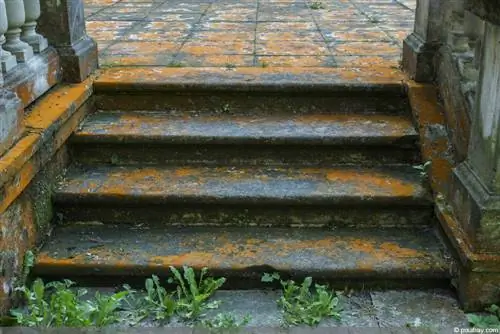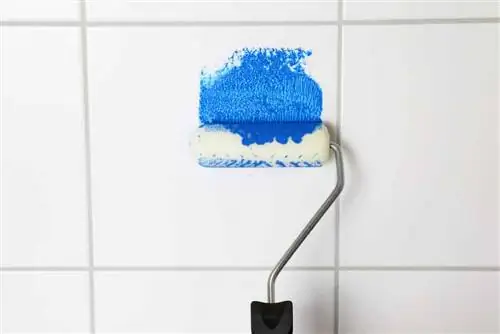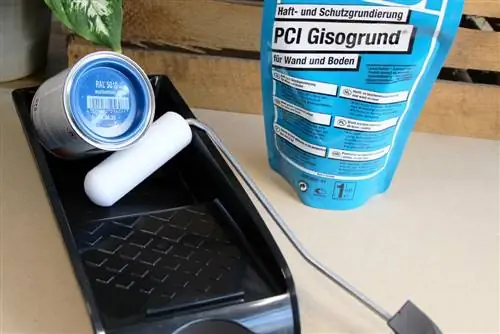- Author admin [email protected].
- Public 2023-12-17 03:39.
- Last modified 2025-01-24 12:45.
Modern latex paint no longer contains latex, but is made from synthetic resin. However, the properties are the same. The paint is often used in damp rooms when tiles cannot be used. Resin-based paint is a little easier to paint over than real latex paint, but it may still make more sense to completely remove it from the wall before painting it again.
Using latex paint
The paint is applied to walls that get dirty easily. They can then be washed with a damp cloth. The disadvantage is that this wall paint is impermeable to air and mold easily forms. That's why the paint has to be removed at some point. It is important to eliminate the mold and not simply paint or cover it up. Because of the risk of mold, latex-based paint was previously often only used on areas of a wall that were particularly prone to soiling:
- about sockets
- on light switches
- a stripe across the floor
If it's just small areas that have been painted with latex wall paint, removal is easy. Larger areas require more effort.
Removal can be attempted with:
- Spirit
- Paint stripper
- Hot air dryer
- Sanding
- Kick off plaster
- Removing wallpaper
Spirit
High-proof alcohol is used in many areas. Also as a solvent. It is easy to use and non-toxic as long as there is good ventilation when using it. Alcohol on the skin can have a drying effect, which is why skin contact should be avoided. Gloves can be worn to work. Denatured alcohol also dissolves latex wall paint. The alcohol is generously applied to the area to be treated and left to work for a few minutes. The paint is then scraped or scraped off the wall.
Work equipment:
- Gloves
- Sponge for application
- Spatula or wire brush
Despite the softening effect of denatured alcohol, removal is laborious and some time must be allowed for. If a wire brush is used, the plaster underneath can also be affected. Spirit is good when it comes to small areas. The room should be well ventilated during and after work. Alcohol fumes can cause drowsiness and dizziness. Smoking is not permitted during work. Alcohol and its vapors are highly flammable.
Paint stripper
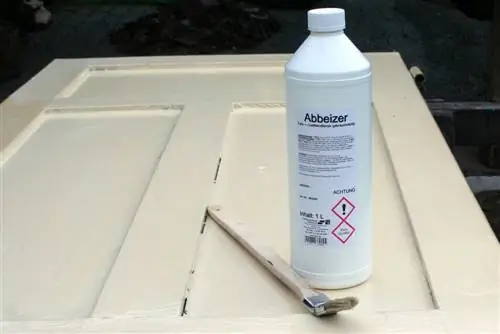
Today's paint strippers no longer contain highly toxic substances, but care should be taken to wear sufficient protective clothing, respiratory protection and gloves. Good ventilation is also important. The paint stripper is applied generously to the area to be treated according to the instructions. The exposure time varies depending on the product, but on average is several hours. Care should be taken to ensure that the top layer does not dry too quickly, so exposure to sunlight or excessively high indoor temperatures should be avoided. Overnight exposure can make sense.
Work equipment:
- Protective clothing
- Apply brush
- Spatula or brush
The effect of the paint stripper is reflected in the more or less severe blistering of the latex paint layer. The dissolved paint is removed with a spatula. The application may need to be repeated if there are several coats of paint. The surface is then thoroughly cleaned with clear water and a brush or sponge.
Kick off plaster
This method is only worthwhile if the renovation work in the room is larger anyway, for example if tiles are to be attached to the wall later. The latex paint is then removed along with the underlying plaster. The entire wall must then be re-plastered.
This method is the most complex, but also the most thorough. There will definitely be no paint residue left afterwards. Plaster can be removed by hand with a hammer and chisel or with special machines from the hardware store. In any case, work clothing and respiratory protection should be worn due to the dust generated. Eye protection is also necessary because of small stones flying around.
Work equipment:
- Protective clothing
- Hammer and chisel
- Drill hammer
- Cleaning machine
- Concrete Grinder
heating air dryer
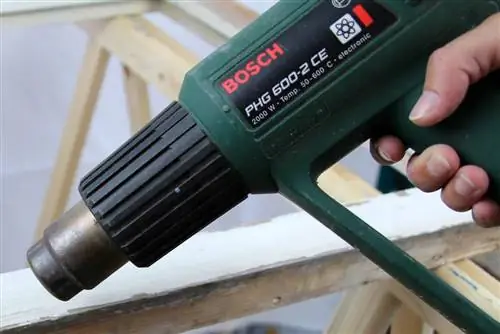
Heat softens the latex paint and ensures that it can be removed with a spatula. However, a hairdryer is not sufficient for this as it does not reach the necessary temperature. A hot air dryer, on the other hand, can reach temperatures of several hundred degrees. It is important to pay attention to fire protection. Good ventilation or respiratory protection is also an advantage. When the paint is heated, harmful fumes can occur. Instead of a hot air dryer, you can also try a steam cleaner. Under certain circumstances, the hot steam can also dissolve the latex paint layer. This method is completely safe, but it doesn't always work.
Work equipment:
- heating air dryer
- possibly steam cleaner
- Spatula
The hot air method or the steam cleaner are particularly gentle on the wall surfaces. The underlying plaster usually remains undamaged.
Remove wallpaper
If the wall was wallpapered and then painted with latex paint, the paint can be removed along with the wallpaper. To remove wallpaper, it is usually soaked with water. However, since latex paint has a water-repellent property, moisture cannot penetrate the wallpaper and detach it from the wall. In the first step, the water-repellent layer must be destroyed.
Work equipment:
- Spiked Roller
- carpet knife
- Painter brush
- Water
- Spatula
Before using a carpet knife or spiked roller, the wallpaper can be inspected for detached areas. If cavities have formed between the wall and the wallpaper or the wallpaper paste no longer holds well, the wallpaper can be removed with a spatula.
If the wallpaper and wall are still firmly connected, the aids are used. The wallpaper is cut generously with a carpet knife. A spiked roller can also be used to perforate the wallpaper.
Then use the paint brush to spread water over the wallpaper. If the strips come off, the wallpaper is removed with the spatula. The wall is then thoroughly cleaned of paste residue and is then ready to be repainted or wallpapered. Attaching tiles to the clean wall is also no problem.
Tip:
Removing latex-based paint is a complex, time-consuming job, regardless of the method. Wherever possible, it should be sanded and painted over instead.
Sanding
Latex-based wall paint can be sanded using various tools. For small areas, sandpaper is enough, but for an entire wall, manual work is very laborious. A drill with a grinding attachment or special grinding machines work better.
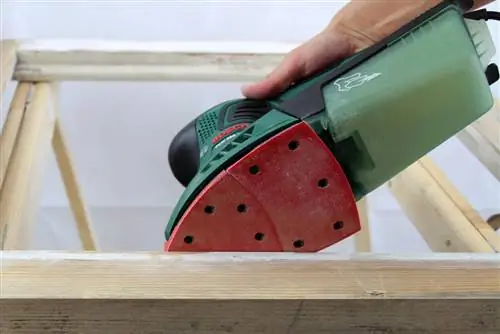
If the paint is applied to plaster, sanding it will be very dusty. Therefore, respiratory protection is advisable. In addition, the plaster layer can be affected. Sanding is a laborious job, even when used mechanically. The area to be treated is sanded until the surface becomes visible. Depending on the thickness or amount of latex paint, this can take quite a while.
Work equipment:
- Sandpaper
- Drill with wire brush attachment
- Grinding machine
- Cleaning machine
After sanding, the plaster may need to be touched up. Sanding dust should be removed thoroughly.


